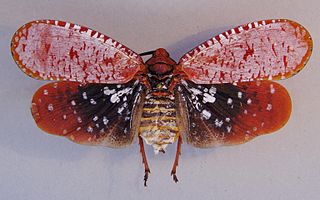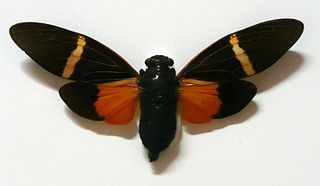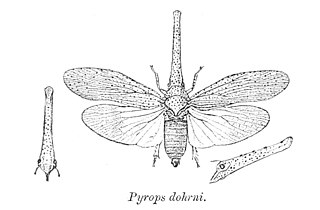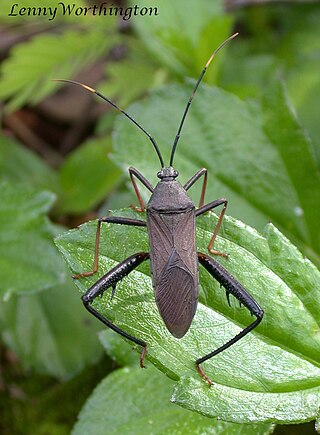
Pentatomidae is a family of insects belonging to the order Hemiptera, generally called shield bugs or stink bugs. Pentatomidae is the largest family in the superfamily Pentatomoidea, and contains around 900 genera and over 4700 species. As hemipterans, the pentatomids have piercing sucking mouthparts, and most are phytophagous, including several species which are severe pests on agricultural crops. However, some species, particularly in the subfamily Asopinae, are predatory and may be considered beneficial.

Papilio is a genus in the swallowtail butterfly family, Papilionidae, as well as the only representative of the tribe Papilionini. The word papilio is Latin for butterfly.

Pentatominae is a subfamily of Pentatomidae, a family of shield bugs. This subfamily is the largest one within the Pentatomidae, having 4937 species classified in 938 genera. Species in this subfamily are phytophages and several of them are considered agricultural pests. Some invasive pentatomines such as Halyomorpha halys and Bagrada hilaris have been considered household pests. Higher systematics of the group have been revised by Rider et al.

Flower chafers are a group of scarab beetles comprising the subfamily Cetoniinae. Many species are diurnal and visit flowers for pollen and nectar, or to browse on the petals. Some species also feed on fruit. The group is also called fruit and flower chafers, flower beetles and flower scarabs. There are around 4,000 species, many of them still undescribed.

Dorcus is a genus of beetles in the stag beetle family Lucanidae. Of the over 100 species, most occur in Asia and India; two are found in southern Europe, and two species are from North America. Previously, specimens with serriform teeth on the mandibles and sable pigment were called Serrognathus whereas specimens with but a singular or multiple bulky notches on the mandibles and lustrous sable pigmentation were called Dorcus.

Euthalia is a genus of brush-footed butterflies. They are commonly called barons or dukes.

Pyrops is a genus of planthoppers that occur primarily in southeast Asia, containing about 70 species. They are fairly large insects, with much of the length due to an elongated, upcurving, snout-like projection of the head. The wings are generally brightly patterned in contrasting colors, and they are popular among collectors.

The subfamily Aphaeninae is a group of hemipteran insects, especially abundant and diverse in the tropics, in the family Fulgoridae, or "lanternflies".

Tosena is a genus of cicadas from South-East Asia. They are the type genus of tribe Tosenini. Species formerly included in Tosena are Distantalna splendida, Formotosena montivaga, Formotosena seebohmi and Trengganua sibylla.

Zanna is a genus of tropical planthoppers found in Asia and Africa, now belonging to the monotypic subfamily Zanninae.

Tosena mearesiana is a cicada species from Southeast Asia. It was described in 1842 by Westwood from a specimen originating from the Himalayas. It has also been recorded from Sikkim in India.

Saiva gemmata is the type species of the genus Saiva, which are lantern bugs found from the North-East of India to Indo-China. No subspecies are listed in the Catalogue of Life.

Dalader is the type genus of coreid bugs in the Daladerini tribe. Species in the genus are distributed in tropical Asia, chiefly Southeast Asia. The genus name is derived from the Sanskrit roots dal meaning leaf and dhru which means bearer. This plant bug genus is distinguished by the which preterminal antennal segment being flattened, pear-shaped, and ridged and the terminal segment being paler. Chalcidoid egg parasites have been recorded from this species. Adults of Dalader acuticosta are fried and eaten in northeastern India.

The Daladerini are a tribe of leaf-footed bugs, in the subfamily Coreinae erected by Carl Stål in 1873. Genera are distributed from Africa to South-East Asia.
Saiva cardinalis is a species of lantern bug in the genus Saiva, found to the North-East of India, Nepal and Vietnam.

Eurybrachys is a genus of bugs in the family Eurybrachidae. First formally named in 1834 by French entomologist Félix Édouard Guérin-Méneville, Eurybrachys is the type genus of the family Eurybrachidae. The spelling Eurybrachis, by the author, is considered an unaccepted orthographic variant. Species in this genus occur in Asia.

The Cloresmini, sometimes called bamboo coreids, are a tribe of leaf-footed bugs, in the subfamily Coreinae erected by Carl Stål in 1873. Genera are distributed from India, China, Indochina, Malesia through to New Guinea.















